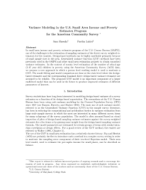
An official website of the United States government
Here’s how you know
Official websites use .gov
A .gov website belongs to an official government organization in the United States.
Secure .gov websites use HTTPS
A lock (
) or https:// means you’ve safely connected to the .gov website. Share sensitive information only on official, secure websites.
-
//
- Census.gov /
- Library /
- Census Working Papers /
- Variance Modeling in the U.S. SAIPE Program for the ACS
Variance Modeling in the U.S. Small Area Income and Poverty Estimates Program for the American Community Survey
Variance Modeling in the U.S. Small Area Income and Poverty Estimates Program for the American Community Survey
Abstract
In small area income and poverty estimates program of the U.S. Census Bureau (SAIPE), one of the challenges is the estimation of sampling variances of the direct survey weighted estimators for the counties. Design-based methods can be highly unreliable primarily because of small sample sizes in the area. Generalized variance function (GVF) methods have been previously used in the SAIPE and other small area estimation projects to obtain smoothed variance estimates. In the context of county level estimation of the number of school-age (5-17 year old) children in poverty using the American Community Survey (ACS) data, we propose a new approach in which a person level working model is used to motivate a GVF. The model fitting and model comparison are done at the state level where the design-based estimates and the corresponding standard direct design-based variance estimates are assumed to be reliable. The proposed GVF model is an important component of a larger multilevel model that can be used in the future to produce improved estimates of different parameters of interest.
Share
Related Information
Some content on this site is available in several different electronic formats. Some of the files may require a plug-in or additional software to view.
 Yes
Yes
 No
NoComments or suggestions?


Top

